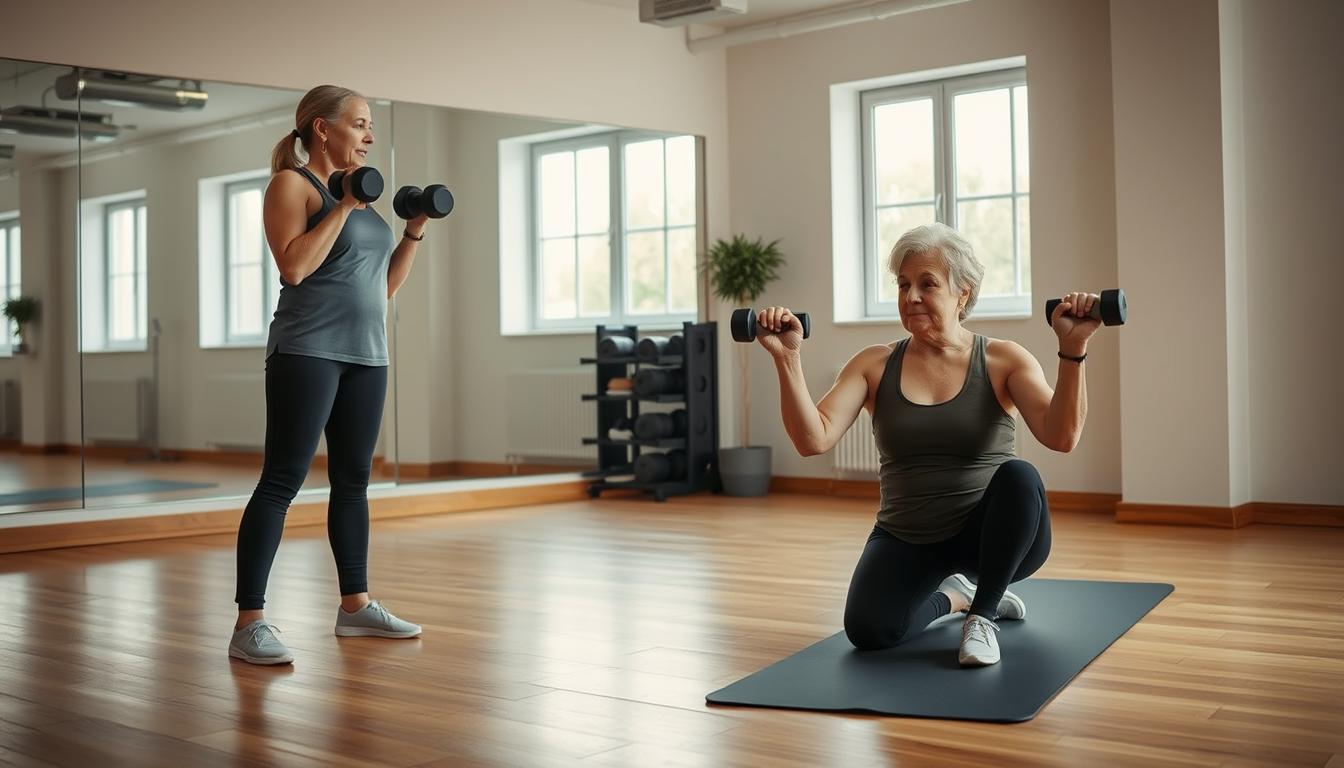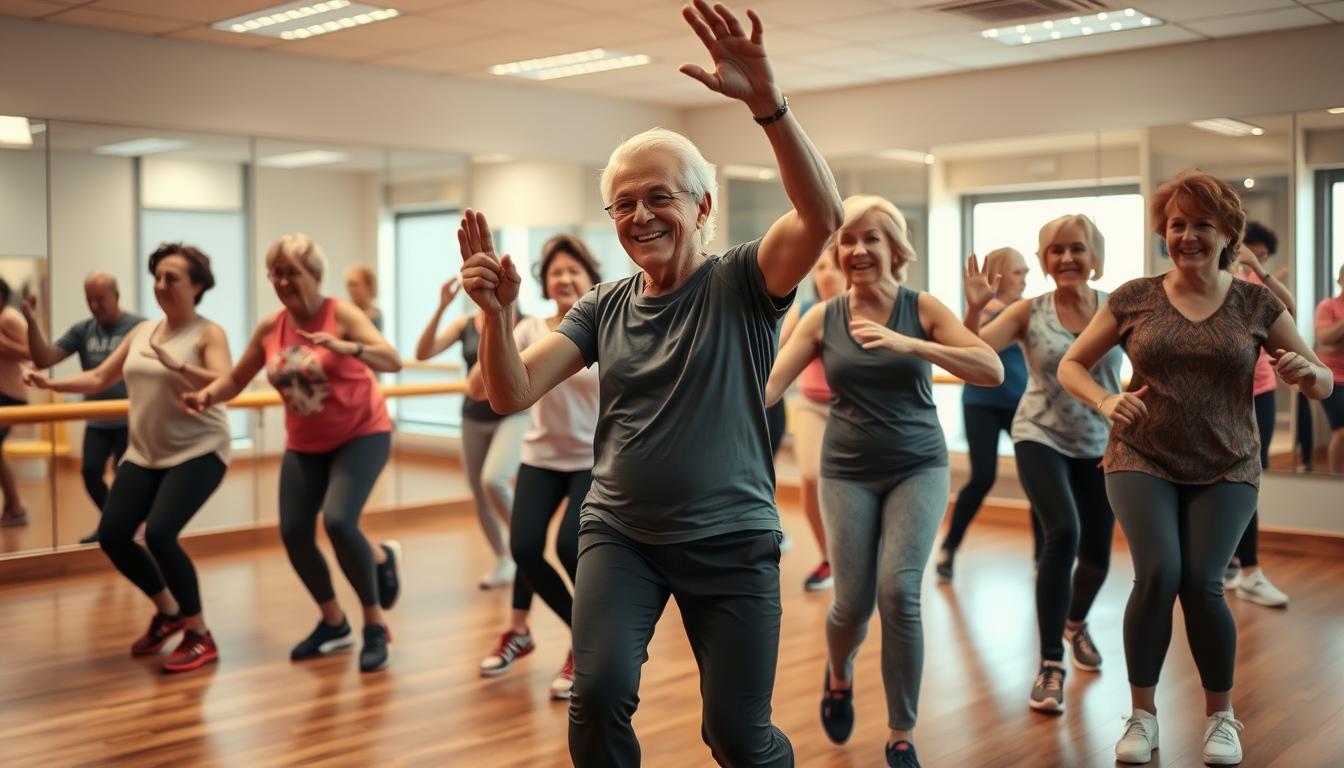Want to outsmart aging and keep doing what you love? Strength training isn’t just for gym rats—it’s your secret weapon. Studies show lifting weights builds bone density, fights muscle loss after menopause, and lets you toss grandkids like confetti without calling for backup. Just ask Abby Bales, a physical therapist who’s seen 70-year-olds squat like they’re 40.
Here’s the kicker: You don’t need barbells or a gym membership. Resistance bands, soup cans, or even grandbaby-lifting sessions count. My neighbor Margaret, 68, deadlifts her gardening pots twice a week. Now she’s the one helping me carry groceries up the stairs.
Science backs this up. Strength workouts trigger hormones that rebuild muscle and bones—critical after 50 when estrogen dips. Think of it as “body armor” against fractures or falls. Plus, it’s cheaper than a fancy anti-aging cream.
Still skeptical? Picture this: You, opening a stubborn pickle jar while your book club watches in awe. Or hiking Machu Picchu instead of worrying about weak knees. That’s the power of a few dumbbells and 20 minutes a day. Let’s break down exactly how—and why—it works.
Understanding the Science Behind Strength Training
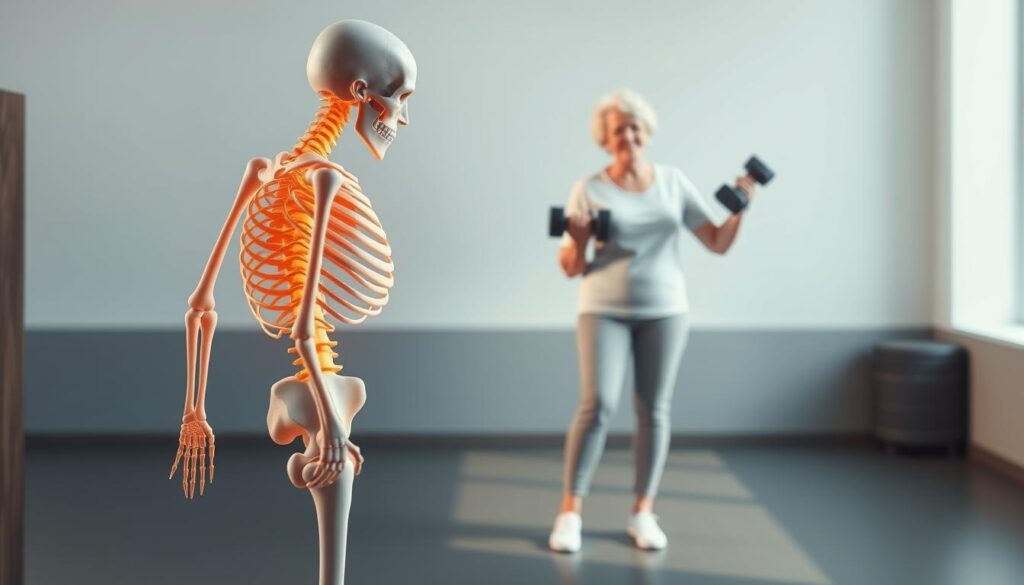
Here’s a wake-up call your body’s been whispering for years: hormones shape your strength more than you realize. After 30, women lose 3-5% of muscle mass per decade—a nosedive that accelerates post-menopause. Why? Plummeting estrogen robs your body’s ability to repair tissue efficiently. But here’s the good news: resistance training flips the script.
Your Hormones vs. Gravity
Think of estrogen as your body’s construction crew. When levels drop, muscles shrink like neglected houseplants. Studies show postmenopausal women can regain 8-10% of lost muscle in 12 weeks with consistent resistance work. It’s not magic—it’s mechanics. Lifting triggers growth hormones that rebuild what time steals.
Bones That Bounce Back
Your skeleton isn’t just scaffolding—it’s alive. Resistance training stimulates osteoblasts, cells that lay down new bone. The International Osteoporosis Foundation found adults who lift weights twice weekly gain 1-3% bone density yearly. Compare that to the 2% loss most experience after 50.
| Without Training | With Training |
|---|---|
| 2% annual bone loss | 1-3% bone gain |
| 5% muscle loss/decade | 8-10% muscle regain |
| Higher fall risk | Improved balance |
Need proof? Look at golfers. Their rotational moves—similar to enhanced mobility exercises—build bone density through impact and resistance. Your body thrives on challenge. Give it weights instead of wishes.
Getting Started with Resistance Training
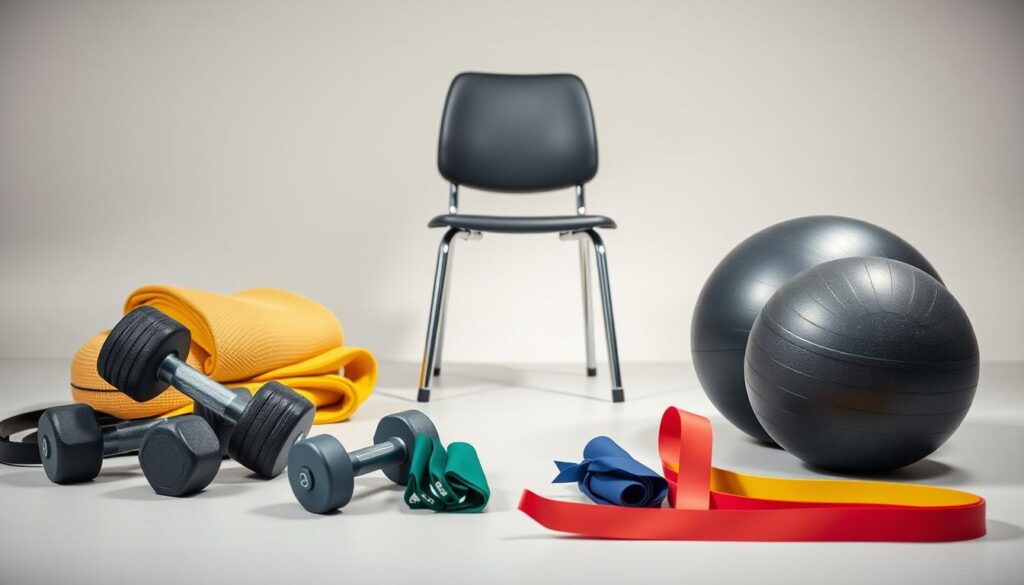
Ready to turn your living room into a powerhouse? Let’s talk equipment you already own. That dining chair? Perfect for seated rows. Water bottles? Instant dumbbells. Start with bodyweight moves like wall push-ups or sit-to-stands—they’re stealthy strength-builders hiding in plain sight.
Choosing Tools That Work For You
Resistance bands cost less than a fancy coffee order and slide under doors for storage. Prefer something sturdier? Grab 5-pound dumbbells or fill empty milk jugs with sand. My client Rita, 67, uses canned goods for overhead presses. “Green beans today, biceps tomorrow,” she jokes.
Crafting Your Safe Space
Clear a 4×4 foot area—enough for arm circles without knocking over lamps. Use a yoga mat or rug for grip. Pro tip: Face a mirror to check your position. Are shoulders relaxed? Knees tracking over toes? Little adjustments prevent big oopsies.
When lifting, palms facing inward protects wrists during curls. If you’re unsure, film yourself or ask a trainer for quick form feedback. Remember: Better technique today means lifting grandkids longer tomorrow.
Start with two 15-minute workouts weekly. Consistency beats intensity every time. Before you know it, you’ll graduate from soup cans to kettlebells—and feel unstoppable doing it.
Weight Lifting for Senior Women: Building Confidence and Independence

Ever carried a full laundry basket upstairs and felt like a superhero? That’s strength training in disguise. What starts as physical power quickly becomes mental armor. Research shows women who lift weights twice weekly report 30% higher self-confidence in daily tasks—like hoisting luggage or rearranging furniture without hesitation.
Here’s why it works: Every rep rebuilds more than muscle. A Journal of Aging and Physical Activity study found participants improved bone density by 2.5% in six months—enough to reduce fracture risk by 15%. But the real win? Walking taller, literally and figuratively. My client Jean, 72, now lifts her own suitcase into overhead bins. “Feeling capable,” she says, “is my secret weapon against aging.”
Three ways strength transforms independence:
- Body as ally: Carrying groceries becomes effortless when your grip matches your grit
- Mindset shift: Conquering heavier weights whispers, “What else can I handle?”
- Social spark: Grandkids beg for “airplane rides” because Grandma’s arms don’t quit
Experts agree: Preserving muscle mass isn’t just about health—it’s freedom. Those who maintain strength halve their risk of needing mobility aids later. Think of it as investing in future adventures, whether that’s gardening marathons or spontaneous road trips.
| Before Training | After 6 Months |
|---|---|
| Struggled with 10-lb bags | Carries 25 lbs comfortably |
| Avoided stairs | Takes two steps at a time |
| Feared falls | Balances on one leg easily |
Start small. Try lifting a filled handbag 10 times daily. Celebrate when it feels lighter—that’s your body and confidence syncing up. Remember: Strong bones and belief grow together.
Fundamental Exercises That Mimic Daily Movements
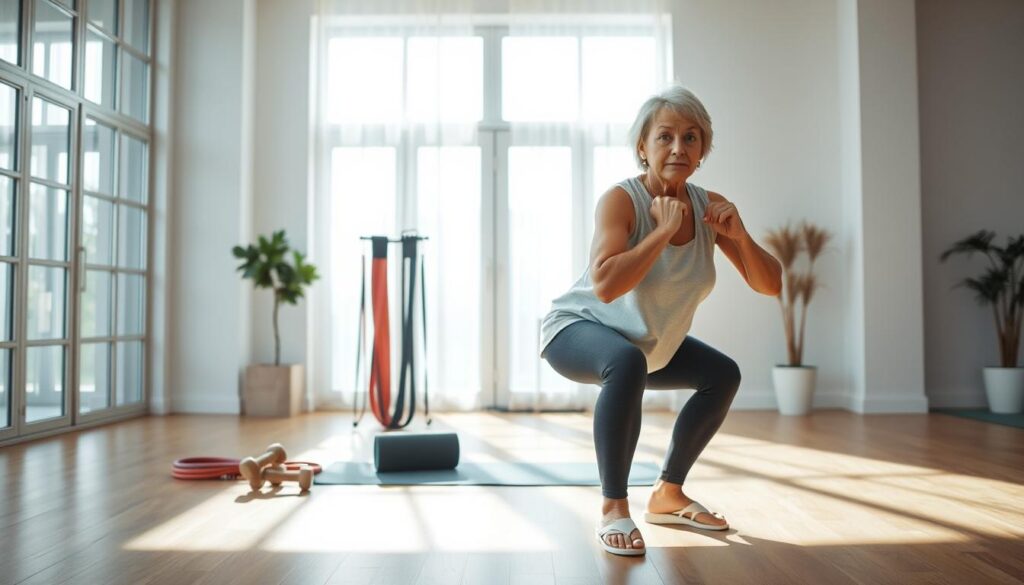
Let’s talk about exercises that feel less like workouts and more like daily life hacks. The best routines mirror what you already do—standing up from a sofa, grabbing a mixing bowl from the top shelf, or bending to pet the dog. These movements matter because they build strength where you need it most: in real-life moments.
Air Squat to Improve Lower Body Strength
Ever struggle to rise from a deep armchair? Meet your new best friend: the air squat. This lower body powerhouse strengthens quads and glutes—the same muscles you use daily. Stand with feet shoulder-width apart, push hips back like you’re closing a car door with your rear, then lower slowly. Pro tip: Pretend you’re sitting into an imaginary chair. Your legs will thank you next time you’re gardening or chasing grandkids.
Overhead Press for Enhanced Mobility
Reaching for that casserole dish? The overhead press trains your shoulders and triceps for exactly that. Hold weights (or soup cans) at ear level with palms facing forward, then press upward until arms straighten. My client Eileen, 71, practices this while putting away groceries. “Now I can lift my grandson’s backpack without wincing,” she laughs. Rotational moves like those in golf fitness routines offer similar benefits.
Take your time with each rep—quality beats speed. Two 20-minute sessions weekly can transform how you move. Remember: Every squat today means easier stairs tomorrow. Every press now keeps your independence intact later. That’s the magic of matching exercise to everyday life.
Incorporating Compound and Isolation Movements

Imagine your muscles as a symphony orchestra—compound movements are the full ensemble playing together, while isolation exercises let individual instruments shine. This dynamic duo works wonders for building functional strength without turning your routine into rocket science.
Why Teamwork Wins
Compound lifts like squats or bent-over rows engage multiple muscle groups at once—think legs, core, and back working in harmony. My client Carol, 69, calls these her “two-for-one specials” because they mimic real-world actions like lifting grandkids or hauling groceries. Research shows these multi-joint exercises boost metabolism 30% more than isolated moves.
But don’t ditch the solo acts. Isolation work—like bicep curls or tricep extensions—polishes specific areas. They’re perfect for addressing weaker spots after your main strength training session. Picture it: compound moves build the house, isolation work paints the trim.
| Compound Benefits | Isolation Perks |
|---|---|
| Works 3+ muscle groups | Targets specific areas |
| Burns more calories | Improves muscle symmetry |
| Enhances coordination | Rehabilitates injuries |
Here’s the sweet spot: Start workouts with 2-3 compound movements, then add 1-2 isolation drills. Use resistance bands or light weights—no need for heavy iron. My golden rule? If you can chat while doing it, you’re probably moving smartly.
Remember: Strength training isn’t about lifting the heaviest load. It’s about waking up every muscle group—from your powerhouse legs to that stubborn upper body—so you can tackle life’s surprises with grace and grit.
Step-by-Step Technique: Mastering the Air Squat
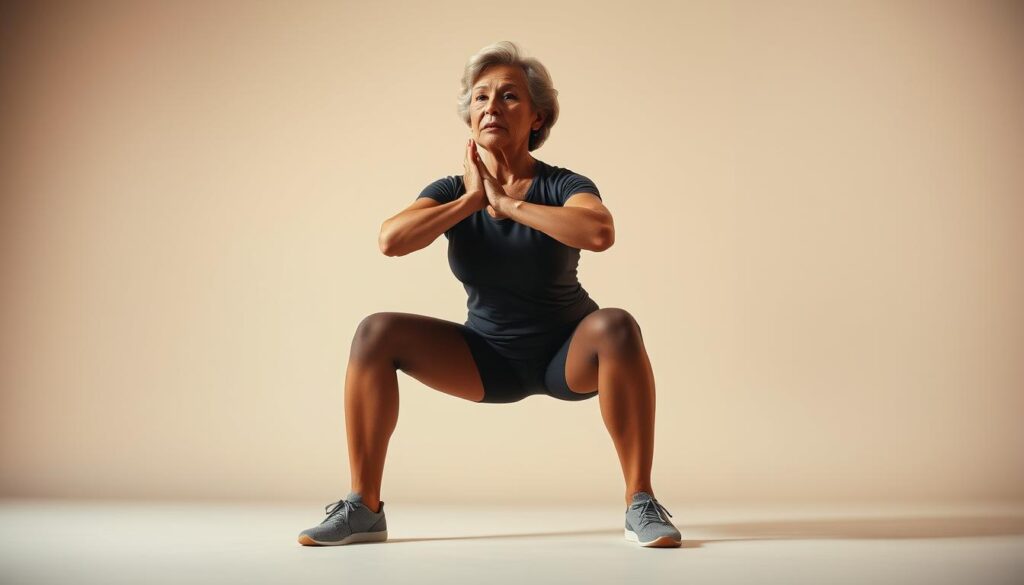
Let’s turn that chair into your squat coach. The air squat isn’t just about bending knees—it’s a full-body conversation between your legs, core, and balance. Start by standing with feet hip-width apart, toes slightly out. Imagine you’re about to sit in a car with a creaky door—push your hips back first, then lower slowly. Keep your chest up like you’re reading a grocery list taped to the wall.
Balancing Tips and Form Adjustments
Make sure your weight stays in your heels—pretend you’re crushing grapes under them. If wobbling happens (it will!), place a chair behind you. Tap the seat lightly with your rear on each rep. This builds confidence while keeping your lower body engaged.
Three quick fixes for shaky squats:
- Hands on hips – Like a superhero pose, this centers your balance
- Slow-mo reps – Count to 3 going down, 2 coming up
- Gaze forward – Pick a spot at eye level to avoid hunching
| Common Mistake | Quick Fix | Benefit |
|---|---|---|
| Knees caving in | Press knees outward | Protects joints |
| Rounding back | Engage core muscles | Spinal safety |
| Rushing reps | Breathe out on ascent | Better control |
Start with 2 sets of 8 reps, resting 30 seconds between. Add one rep weekly until you hit 12. Your form matters more than depth—quality over quantity every time. My client Bonnie, 65, now does squats while waiting for her tea kettle. “It’s like brushing teeth,” she says. “Just part of the day.”
Remember: Strong legs aren’t just for exercise. They’re for rising from garden stools, petting big dogs, and dancing at family weddings. Nail the basics first—the confidence comes free.
Designing Your Weekly Resistance Training Routine
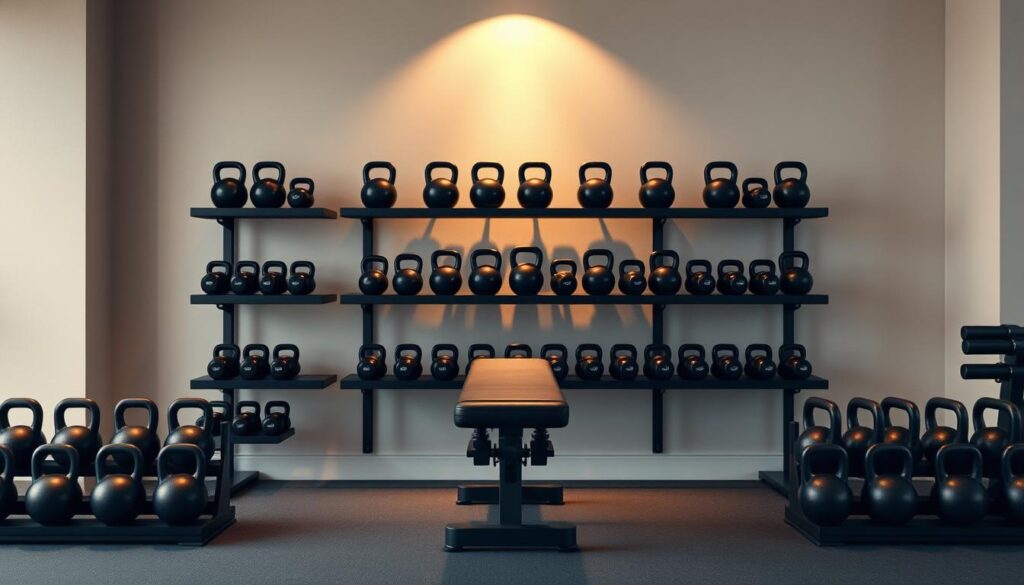
Let’s map out your week like a treasure hunt—each session uncovers new strength. Start with two 20-minute workouts spaced evenly, say Tuesday and Friday. This gives muscles time to repair while keeping momentum. By week three, sneak in a third session—maybe a Saturday morning quickie while coffee brews.
Structuring Sessions to Build Gradually
Think of your first month as “foundation phase”. Alternate between upper and lower body days. Mondays: chair squats and overhead presses. Thursdays: resistance band rows and step-ups. Keep weights light enough to complete 12 reps without strain. My client Marion, 68, started with 3-pound cans and now deadlifts 15 pounds—progress happens faster than you’d think.
| Week 1-2 | Week 3-4 |
|---|---|
| 2 sessions weekly | Add 1 session |
| Bodyweight moves | +2 lbs per exercise |
| 8 reps per set | 10-12 reps |
Tracking Progress Without Overdoing It
Grab a fridge calendar and slap gold stars on completed workouts. Feeling fancy? Note which exercises felt easier each week—that’s your body adapting. If you breeze through 12 reps of bicep curls, it’s time to swap soup cans for slightly heavier jars.
Three signs you’re nailing the balance:
- Muscles feel worked, not wrecked, next day
- Energy levels stay steady between sessions
- You look forward to workouts instead of dreading them
Rest days are where the magic happens—they let muscles rebuild stronger. Skip them, and you’ll plateau faster than a soufflé in a drafty kitchen. Remember: Consistency trumps intensity. Miss a day? No guilt trips. Just pick up where you left off.
Safety First: Perfecting Form, Warm-Ups, and Recovery
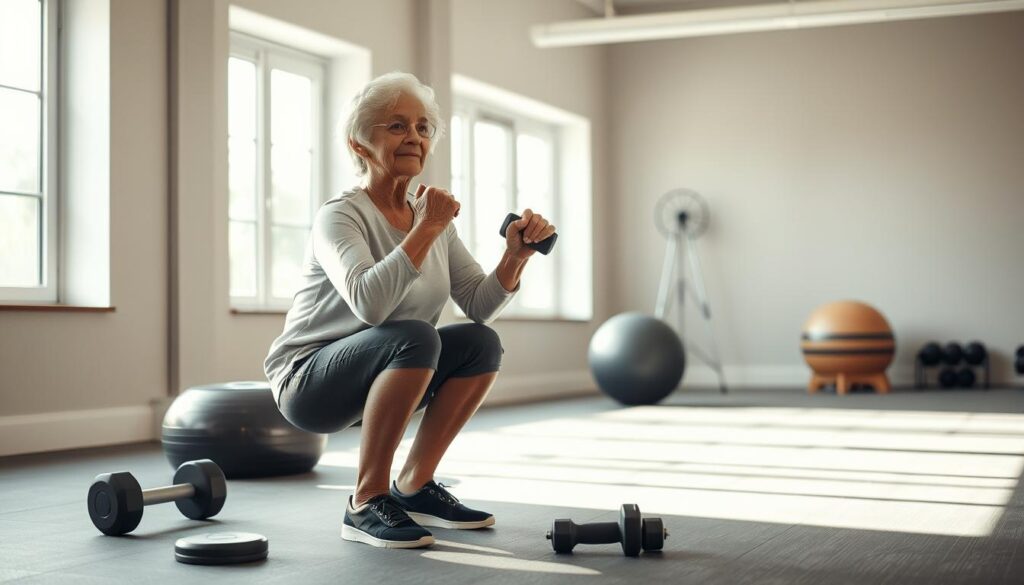
Safety isn’t about bubble wrap—it’s your secret weapon for staying strong. Think of warm-ups and cool-downs as your body’s seatbelt and airbag. Skip them, and you’re cruising for bruises. Here’s how to protect joints, honor your lower back, and keep workouts joyful.
Pre-Workout Routines to Prevent Injury
Five minutes can save weeks of recovery. Start with dynamic stretches like arm circles or leg swings—they prep muscles like buttering a warm pan. Check equipment: frayed resistance bands or wobbly chairs? Swap them fast. My client Bev, 73, does a “safety sweep” before lifting: “If I wouldn’t trust it with my cat, I won’t use it.”
| Pre-Workout Essentials | Post-Workout Musts |
|---|---|
| 3-5 min dynamic stretches | 2 min deep breathing |
| Check equipment stability | Hold stretches 30 sec |
| Practice proper form with no weight | Hydrate + refuel |
Mindful Cooling Down and Stretching
Cooling down isn’t optional—it’s where gains cement. Spend three minutes walking slowly or doing seated twists. Focus on balance stability during stretches: stand near a wall if needed. Notice tingling or sharp pain? That’s your body’s “check engine” light. Ease up.
Three post-workout red flags:
- Dizziness lasting over 2 minutes
- Sudden lower back tightness
- Swelling in joints
Remember: Resistance training shields joints when done right. Pair smart prep with gentle recovery, and you’ll build strength that outlasts the years.
Tactical Adjustments for Aging Bodies and Unique Needs

Think of your workout routine as a favorite recipe—sometimes it needs tweaking to suit changing tastes. As we get older, our bodies crave smart modifications, not less intensity. The key? Swap what strains for what sustains.
Modifying Techniques for Enhanced Stability
Facing natural age-related changes doesn’t mean surrendering progress. Try seated exercises if balance feels shaky—like using a chair for supported rows. Adjust levels of resistance by trading dumbbells for loop bands. My client Rita, 68, swapped standing overhead presses for wall pushes: “My shoulders still burn, but my knees don’t complain.”
| Standard Exercise | Modified Version | Benefit |
|---|---|---|
| Standing Squats | Seated Sit-to-Stands | Reduces knee strain |
| Lunges | Step-Ups on Low Stairs | Improves stability |
| Planks | Incline Push-Ups | Protects lower back |
Combat muscle loss by slowing your pace. Take 4 seconds to lower a weight instead of 2—this builds endurance while safeguarding joints. If issues like arthritis flare up, rotate grip positions during curls to ease pressure.
Here’s how to get started: Pick one move per session to modify. Try bent-over rows with soup cans before progressing to weights. Celebrate small wins—like holding a plank 5 seconds longer. Your muscles adapt faster when challenged kindly.
Remember: Building muscles after 50 isn’t about lifting heavier. It’s about lifting smarter. Adjust your levels, honor your body’s cues, and watch strength outpace the years.
Heavy Lifting Insights: Overload, Not Overstrain

Progressive overload works like a slow-cooked stew—add too much too fast, and you’ll ruin the flavor. The trick? Small, strategic increases that challenge your muscle without overwhelming joints. Research shows adding just 5% more resistance every 2-3 weeks builds strength safely. Think of it as turning up the volume knob—not slamming it to max.
Gradual Weight Increase to Protect Joints
Your body thrives on smart challenges. Here’s how to level up without strain:
- Test your baseline: Can you complete 12 reps with perfect position? If yes, add 1-2 pounds next session
- Time your jumps: Wait until movements feel “easy” before increasing—usually 3-4 workouts
- Listen to feedback: Aching wrists or creaky knees? Dial back 10% and rebuild
| Safe Progression | Risky Rush |
|---|---|
| +5% weight monthly | Doubling load weekly |
| Focus on form first | Sacrificing position for reps |
| Alternate muscle groups | Same exercises daily |
I’ve seen clients boost bone density 2% faster by tracking their sets reps in a notebook. One secret? Pair heavier days with extra recovery. My client Lois, 71, alternates between resistance bands and light weights—her joints stay happy while her muscle keeps growing.
When in doubt, consult a trainer for personalized tweaks. They’ll spot imbalances you might miss, like leaning too far forward during lifts. Remember: Progress isn’t linear. Some weeks you’ll feel unstoppable—others, a step back protects your long-term work.
Expert Tips and Stories from Real Senior Lifters

What’s the secret sauce to staying strong after 60? According to Marilynn Larkin, it’s deadlifting grandkids and doing bicep curls with grocery bags. “I call it ‘functional chaos,’” she laughs. “My upper body didn’t know it was working until I started hoisting my new puppy.”
When Life Becomes the Gym
Ginny MacColl, 74, swears by her “countertop push-ups” while waiting for toast. “Three reps every morning—now I can lift my terrier without groaning.” Her fitness level skyrocketed when she swapped gym sessions for playful exercises like squatting to pet stray cats or lunging for dropped keys.
Research backs this approach. A Journal of Aging Research study found women who integrated strength moves into daily tasks gained 40% more muscles than those doing structured workouts. The key? Consistency over complexity.
| Challenge | Real-Life Fix | Outcome |
|---|---|---|
| Weak grip | Opening jars instead of cans | +25% hand strength |
| Poor balance | Standing on one leg while brushing teeth | Better balance stability |
| Low energy | Wall push-ups during TV ads | Higher stamina |
Dr. Helen Kimmel, a geriatric specialist, notes: “Five minutes of targeted exercise daily does more for bone density than sporadic marathons.” Her patients use soup cans for lateral raises and stairs for step-ups—no fancy gear required.
Take inspiration from Ethel, 69, who does seated leg lifts while chatting with friends. “My body thinks we’re gossiping—my quads disagree!” Small efforts compound. A strong week of movement builds a resilient decade.
Keeping the Momentum Alive With Consistent Training
Think of your strength journey as a garden—daily care yields lasting blooms. Small, steady efforts matter most. Add one rep to your curls this week. Swap canned beans for broth next month. Progress isn’t about giant leaps—it’s the drip that fills the bucket.
Building muscle mass works like retirement savings. You wouldn’t cram 40 years of deposits into one day. My client Gail, 71, adds 30 seconds to her planks each training session. Now she hoists her grand-pup like a pro. Consistency trumps intensity every time.
Here’s the magic: Every exercise session—even 10 minutes—fuels long-term gains. Miss a day? No guilt. Just pick up where you left off. Track progress with fridge sticky notes or a fitness app. Celebrate when week three’s “hard” weight feels light.
Adjust routines as your muscles adapt. Swap resistance bands for weights when rows feel easy. Try chair-assisted squats if balance wobbles. Strength training evolves with you—like a favorite recipe tweaked over decades.
Remember: The goal isn’t perfection. It’s showing up, adjusting, and trusting the process. Your future self will thank you—one strong, mindful rep at a time.
